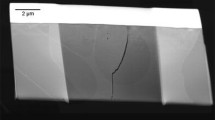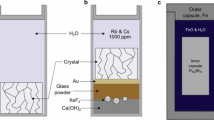Abstract
We performed multi-anvil experiments in the system MgO-SiO2 ± H2O at 13.0–13.7 GPa and 1,025–1,300°C and in the system MgO-FeO-SiO2 ± H2O, under reducing conditions, at 11.0–12.7 GPa and 1,200°C, to depict the effect of H2O on the P-T-x coordinates of the 410-km discontinuity, i.e. the olivine–wadsleyite phase boundary. The charges were investigated with Electron Microprobe (EMP), Raman Spectroscopy, Fourier Transform Infrared Spectroscopy (FTIR), Secondary Ion Mass Spectrometry (SIMS) and Electron Energy Loss Spectroscopy (EELS). We observe in the MgO-SiO2-H2O system at 1,200°C a 0.6 GPa shift of the phase boundary to lower pressure compared to dry conditions, due to the stronger water fractionation into wadsleyite (wad) rather than in olivine (ol). In the MgO-FeO-SiO2-H2O system, we reproduced the triple point, i.e. observed coexisting hydrous ol, wad and ringwoodite (ring). SIMS H quantifications provided partitioning coefficients for water: \( D_{\text{wad/ol}}^{\text{water}} \) ~ 3.7(5) and \( D_{\text{ring/ol}}^{\text{water}} \) ~ 1.5(2) and \( D_{\text{wad/ring}}^{\text{water}} \) ~ 2.5(5). For a bulk composition of x Fe = 0.1, our data indicate only a slight difference in the width of the loop of the two phase field ol–wad under hydrous conditions compared to dry conditions, i.e. no broadening with respect to composition but a shift to lower pressures. For bulk compositions of x Fe > 0.2, i.e. in regions where wad–ring and ol–ring coexist, we observe, however, an unexpected broadening of the loops with a shift to higher iron contents. In total, the stability field of hydrous wad expands in both directions, to lower and higher pressures. Fe3+ concentrations as determined by EELS are very low and are expected to play no role in the broadening of the loops.






Similar content being viewed by others
Notes
Further on expressed either with wt ppm H2O or with the general term “water”.
References
Agee CB (1998) Phase transformations and seismic structure in the upper mantle and transition zone. In: Ultrahigh-pressure mineralogy: physics and chemistry of the earth’s deep interior. Mineralogical Society of America
Armstrong JT (1995) CITZAF—a package of correction programs for the quantitative electron microbeam x-ray analysis of thick polished materials, thin films, and particles. Microbeam Anal 4:7–200
Chen J, Inoue T, Yurimoto H, Weidner JD (2002) Effect on olivine-wadsleyite phase boundary in the (Mg, Fe)2SiO4 system. Geophys Res Lett 29(18):1875
Demouchy S, Deloule E, Frost DJ, Keppler H (2005) Temperature and pressure dependence of water solubility in iron-free wad. Am Mineral 81:1084–1091
Deon F, Koch-Müller M, Rhede D, Gottschalk M, Wirth R, Thomas S-M (2009) Location and quantification of hydroxyl in wadsleyite: new insights. Am Mineral 95:312–322
Dziewonski AM, Anderson DL (1981) Preliminary reference earth model. Phys Earth Planet Inter 25:297–356
Frost DJ, Dolejs D (2007) Experimental determination of the effect of H2O on the 410-km discontinuity. Earth Planet Sci Lett 256:182–195
Frost DJ, McCammon C (2009) The effect of oxygen fugacity on the olivine to wadsleyite transformation: implications for a remote sensing of mantle redox state at the 410-km seismic discontinuity. Am Mineral 94:872–882
Garvie LAJ, Buseck PR (2004) Unoccupied states of pyrite probed by energy-loss spectroscopy (EELS). Am Mineral 89:485–491
Inoue T, Yurimoto H, Kudoh Y (1995) Hydrous modified spinel, Mg1.75SiH0.5O4: a new reservoir in the mantle transition region. Geophys Res Lett 22:117–120
Inoue T, Wada T, Sasaki R, Irifune T, Yurimoto H (2003) Partitioning of H2O on high pressure phase transformation of olivine. American Geophysical Union, Fall Meeting (abstract #V42A-0318)
Katsura T, Ito E (1989) The system Mg2SiO4-Fe2SiO4 at high pressures and temperatures: precise determination of stabilities of olivine, modified spinel, and spinel. J Geophys Res 97:15663–15670
Katsura T, Yamada H, Nishikawa O, Song M, Kubo A, Shinmei T, Yokoshi S, Aizawa Y, Yoshino T, Walter MJ, Ito E (2004) Olivine-wadsleyite transition in the system (Mg, Fe)2SiO4. J Geophys Res 109:B02209
Kawamoto T (2004) Hydrous phase stability and partial melt chemistry of H2O-saturated KLB-1 peridotite up to the uppermost lower mantle conditions. Phys Earth Planet Inter 143–144:387–395
Keppler H, Bolfan-Casanova N (2006) Thermodynamics of water solubility and partitioning. In: Keppler H, Smyth JR (eds) Water in nominally anhydrous minerals, vol. 62. American Mineralogical Society. Geochemical Society, Chantilly, pp 193–230
Kerschhofer L, Dupas C, Ming L, Sharp TG, Durham WB, Rubie D (1998) Polymorphic transformations between olivine, wadsleyite and ringwoodite: mechanisms of intracrystalline nucleation and the role of elastic strain. Miner Mag 62(5):617–638
Koch-Müller M, Rhede D (2010) IR absorption coefficients for water in nominally anhydrous high-pressure minerals. Am Mineral 95:770–775
Koch-Müller M, Matsyuk SS, Rhede D, Wirth R, Khisina N (2006) Hydroxyl in mantle olivine xenocrysts from Udachnaya kimberlite pipe. Phys Chem Miner 33:276–287
Koch-Müller M, Rhede D, Schulz R, Wirth R (2009) Breakdown of hydrous ringwoodite to pyroxene and spinelloid at high P and T and oxidizing conditions. Phys Chem Miner 36:329–341
Kohlstedt DL, Keppler H, Rubie DC (1996) Solubility of water in the α, β and γ phases of (Mg, Fe)2SiO4. Contrib Miner Petrol 123:345–357
Lauterbach S, McCammon CA, Van Aken P, Langenhorst F, Seifert F (2000) Mössbauer and ELNES spectroscopy of (Mg, Fe)(Al, Si)O3 perovskite: a highly oxidized component of the lower mantle. Contrib Miner Petrol 138:17–26
Libowitzky E, Rossman GR (1997) An IR absorption calibration for water in minerals. Am Mineral 82:1111–1115
Maldener J, Hösch A, Langer K, Rauch F (2003) Hydrogen in some natural garnets studied by nuclear reaction analysis and vibrational spectroscopy. Phys Chem Miner 30:337–344
Morishima H, Kato T, Suto M, Ohtani E, Urakawa S, Utsumi W, Shimomura O, Kikegawa T (1994) The phase boundary between α-and β-Μg2SiO4 determined by in situ X-ray observation. Science 26:1202–1203
Mosenfelder JD, Deligne NI, Asimow PD, Rossman GR (2006) Hydrogen incorporation in olivine from 2–12 GPa. Am Mineral 91:285–294
Paterson MS (1982) The determination of hydroxyl by infrared absorption in quartz, silicate glasses and similar materials. Bull Minéral 105:20–29
Ringwood AE (1975) Composition and petrology of the earth′s mantle. McGraw Hill, New York
Ross NL (1997) Optical absorption spectra of transition zone minerals and implications for radiative heat transport. Phys Chem Earth 22:113–118
Rossman GR (2006) Analytical methods for measuring water in nominally anhydrous minerals. In: Keppler H, Smyth JR (eds) Water in nominally anhydrous minerals,vol. 62. American Mineralogical Society. Geochemical Society, Chantilly, pp 1–28
Rost R, Weber M (2002) The upper mantle transition zone discontinuities in the Pacific as determined by short period term array data. Earth Planet Sci Lett 204:347–361
Schmidt MW, Ulmer P (2004) A rocking multi-anvil: elimination of chemical segregation in fluid-saturated high-pressure experiments. Geochim Cosmochim Acta 68:1889–1899
Smyth JR (1987) β-Mg2SiO4: a potential host for water in mantle? Am Mineral 72:1051–1055
Smyth JR (2006) Hydrogen in high pressure silicate and oxide mineral structures. Rev Miner Geochem 62:85–115
Thomas S-M, Thomas R, Davidson P, Reichart P, Koch-Müller M, Dollinger G (2008) Application of Raman spectroscopy to quantify trace water concentrations in glasses and garnets. Am Mineral 93:1550–1557
Thomas S-M, Koch-Müller M, Reichart P, Rhede D, Thomas R, Wirth R, Matsyuk S (2009) IR calibrations for water determination in olivine, r-GeO2 and SiO2 polymorphs. Phys Chem Miner. doi 10.1007/s00269-009-0295-1
Van Aken PA, Liebscher B, Styrsa VJ (1998) Quantitative determination of iron oxidation states in minerals using Fe L 2, 3-edge electron energy-loss near-edge structure spectroscopy. Phys Chem Miner 25:323–327
van der Meijde M, van der Lee S, Giardini D (2003) Seismic evidence for water deep in earth′s upper mantle. Science 300:1156–1558
Walker D (1991) Lubrication, gasketing, and precision in multi-anvil experiments. Am Mineral 76:1092–1100
Wirth R (2004) A novel technology for advanced application of micro- and nanoanalysis in geosciences and applied mineralogy. Eur J Miner 16(6):863–876
Wood BJ (1995) The effect of H2O on the 410-km seismic discontinuity. Science 268:74–76
Yamazaki A, Hirahara K (1994) The thickness of the upper mantle discontinuities as inferred from short-period J-Array data. Geophys Res Lett 21:1811–1818
Acknowledgments
We thank Reiner Schulz for his important help and technical support during the multi-anvil press experiments and Julia Pohlenz. We are also very grateful to Dr. Michael Wiedenbeck for the precious help during the SIMS measurements. Further, we greatly appreciated the help of Oona Appelt (EMPA), Ilona Schäpan (SIMS) and the precious work of Anja Schreiber who prepared the FIB foils that were analyzed at TEM. We also thank Hans-Peter Nabein for his help in collecting the powder XRD-diffraction pattern. Last but not least, we are very grateful to Stefan Gehrmann and Gerhard Berger who prepared the samples for the EMPA and SIMS. The quality of this manuscript was improved, thanks to the suggestion and comments by an anonymous reviewer and of the editor Jochen Hoefs. This study was supported by a grant from Deutsche Forschungsgemeinschaft within the priority program SPP1236 under grant KO1260/7-1.
Author information
Authors and Affiliations
Corresponding author
Additional information
Communicated by J. Hoefs.
Rights and permissions
About this article
Cite this article
Deon, F., Koch-Müller, M., Rhede, D. et al. Water and Iron effect on the P-T-x coordinates of the 410-km discontinuity in the Earth upper mantle. Contrib Mineral Petrol 161, 653–666 (2011). https://doi.org/10.1007/s00410-010-0555-6
Received:
Accepted:
Published:
Issue Date:
DOI: https://doi.org/10.1007/s00410-010-0555-6




